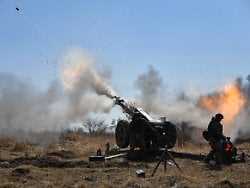NVA weapons for Ukraine
Estonia still hopes for howitzer release wwg
2/10/2022 7:09 am
With nine old howitzers from the stocks of the East German army, Estonia wants to arm the Ukraine for a possible Russian attack – but Berlin’s approval is required for this. The question has become a symbol of the struggle to find the right way to deal with Putin. Today Scholz meets the Baltic States.
Estonia is still awaiting feedback from the federal government on its request for a license to supply artillery pieces to Ukraine. “We still don’t have an official answer from Germany regarding the howitzers,” Prime Minister Kajas Kallas said before her visit to Germany.
Estonia wants to give Ukraine nine howitzers from old GDR stocks – but the EU and NATO member has undertaken to obtain Germany’s consent before passing them on to third parties. This is necessary because the weapons were first sold to Finland with conditions and then later given to Estonia from there.
“It’s up to each country what kind of help it wants to offer Ukraine. We think it’s very important to help Ukraine in any way we can,” Kallas said. “Estonia stands ready to provide arms and ammunition to help Ukraine, in cooperation with our allies, defend against Russian aggression.”
Kallas is expected in Berlin on Thursday, together with her Latvian colleague Krisjanis Karins and the Lithuanian President Gitanas Nauseda, for talks with Chancellor Olaf Scholz. It should particularly deal with the Ukraine crisis and the security situation in Eastern Europe.
Again talks in Normandy format
Along with Poland, the former Soviet republics of Estonia, Latvia and Lithuania are among the EU countries that border Russia. They therefore feel particularly threatened by the powerful neighboring country. The Balts advocate a hard line against Moscow and reject the Nord Stream 2 gas pipeline from Russia to Germany.
In addition to the Balten summit, there will be another important meeting on Thursday in Berlin regarding the Ukraine crisis: the conflicting parties Russia and Ukraine will be sitting at the same table for the second time since troops began to deploy on the Ukrainian border. The foreign policy advisers of the two presidents meet with their colleagues from Germany and France in the so-called Normandy format.
Efforts to resolve the crisis are also continuing at other levels. US President Joe Biden spoke to French President Emmanuel Macron on the phone after his visits to heads of state in Moscow and Kiev. Both spoke on ongoing diplomatic initiatives and “deterrence efforts” in close coordination with allies, the White House said.
Great Britain is also continuing its diplomatic efforts in the Ukraine conflict. Prime Minister Boris Johnson is expected to meet NATO Secretary General Jens Stoltenberg in Brussels on Thursday morning and will also travel to Poland. There he wants to speak to President Andrzej Duda and Prime Minister Mateusz Morawiecki. Johnson traveled to Kiev last week.
Military maneuvers in Belarus and Ukraine
British Foreign Secretary Liz Truss arrived in Moscow on Wednesday for a two-day visit. After landing, she asked Russia to immediately withdraw its troops from the Ukrainian border. “Any intrusion would be a huge mistake. Diplomacy is the only way, and Russia must follow that path,” Truss said. Her government also had 1,000 more soldiers stationed in Britain on standby “to support NATO and allies in the event of a humanitarian crisis (in the conflict region)”. The Ministry of Defense had already announced on Monday that it would send 350 more soldiers to Poland.
Parallel to the ongoing peace efforts and diplomatic initiatives, Russia and Belarus want to officially start joint military maneuvers on Thursday. The exercises, for example in southern Belarus on the border with Ukraine, are necessary in view of the “unprecedented threat,” said Kremlin spokesman Dmitry Peskov, according to the Interfax agency. These are not the first exercises of this kind, but this time they were larger than usual because of the tensions with the West. In the past few days there had already been individual maneuvers by both armies.
NATO accuses Russia of relocating around 30,000 soldiers to Belarus, which creates a threat to neighboring Ukraine. Moscow, on the other hand, emphasized that the exercise was in accordance with international law and that the maximum number of soldiers stipulated would not be exceeded. The Russian armed forces should also leave Belarus again after the end of the maneuver. At the same time as the Russian-Belarusian maneuvers, neighboring Ukraine also announced nationwide military exercises, primarily in dealing with new Western weapons.
